Systematic Evidence Mapping to Assess the Sustainability of Bioplastics Derived from Food Waste: Do We Know Enough?
Abstract
:1. Introduction
- (i)
- collect peer-review evidence on the sustainability performance of FLW-derived bioplastics from a multidimensional perspective including environmental, economic, social and technical aspects through systematic evidence mapping; and
- (ii)
- critically assess whether the status quo of FLW-derived bioplastics from a sustainability perspective would enable their wider adoption based on this evidence mapping.
2. Background Information
- Direct extraction of biopolymers from biomass (e.g., extraction of polysaccharides, such as starch and cellulose, and proteins, such as gluten);
- Production by a range of microorganisms cultured under several nutrient and environment conditions conducted in batch and fed-batch reactors. Characteristically, PHAs are synthesised intracellularly by PHA-producing bacteria, such as Cupriavidus necator;
- Synthesis from bio-based monomers through fermentation of carbohydrates by bacterial microorganisms into biopolymer precursors (i.e., renewable bio-based monomers) followed by polymerisation processes, such as PLA.
3. Methodology
3.1. Eligibility Criteria
3.2. Search Strategy
3.3. Data Collection Process
4. Results
4.1. FLW Acquisition and FLW-Derived Bioplastics Production
4.1.1. Environmental Performance
4.1.2. Economic Performance
4.1.3. Technical Performance
4.2. Consumption and EoL Management
5. Discussion
6. Conclusions
Supplementary Materials
Author Contributions
Funding
Institutional Review Board Statement
Informed Consent Statement
Data Availability Statement
Conflicts of Interest
References
- EuropeanBioplastics. What Are Bioplastics? Available online: https://www.european-bioplastics.org/bioplastics/ (accessed on 21 May 2022).
- Gerassimidou, S.; Martin, O.V.; Chapman, S.P.; Hahladakis, J.N.; Iacovidou, E. Development of an integrated sustainability matrix to depict challenges and trade-offs of introducing bio-based plastics in the food packaging value chain. J. Clean. Prod. 2021, 286, 125378. [Google Scholar] [CrossRef]
- Samantaray, P.K.; Little, A.; Wemyss, A.M.; Iacovidou, E.; Wan, C. Design and Control of Compostability in Synthetic Biopolyesters. ACS Sustain. Chem. Eng. 2021, 9, 9151–9164. [Google Scholar] [CrossRef]
- Shen, L.; Worrell, E.; Patel, M. Present and future development in plastics from biomass. Biofuels Bioprod. Biorefining Innov. A Sustain. Econ. 2010, 4, 25–40. [Google Scholar] [CrossRef]
- Directive (EU) 2018/851. Directive (EU) 2018/851 of the European Parliament and of the Council of 30 May 2018 Amending Directive 2008/98/EC on Waste. Off. J. Eur. Union 2018, 150, 109–140. [Google Scholar]
- FUSION. FUSIONS Definitional Framework for Food Waste. Available online: https://www.eu-fusions.org/phocadownload/Publications/FUSIONS%20Definitional%20Framework%20for%20Food%20Waste%202014.pdf (accessed on 21 May 2022).
- FAO. Definitional Framework of Food Loss. Available online: https://www.sciencedirect.com/science/article/pii/B978012823306100011X (accessed on 25 July 2022).
- FAO. Food Wastage Footprint. Available online: https://www.fao.org/nr/sustainability/food-loss-and-waste/en/ (accessed on 21 May 2022).
- Hamed, I.; Jakobsen, A.N.; Lerfall, J. Sustainable edible packaging systems based on active compounds from food processing byproducts: A review. Compr. Rev. Food Sci. Food Saf. 2022, 21, 198–226. [Google Scholar] [CrossRef]
- Tsang, Y.F.; Kumar, V.; Samadar, P.; Yang, Y.; Lee, J.; Ok, Y.S.; Song, H.; Kim, K.-H.; Kwon, E.E.; Jeon, Y.J. Production of bioplastic through food waste valorization. Environ. Int. 2019, 127, 625–644. [Google Scholar] [CrossRef] [PubMed]
- Dutt Tripathi, A.; Paul, V.; Agarwal, A.; Sharma, R.; Hashempour-Baltork, F.; Rashidi, L.; Khosravi Darani, K. Production of polyhydroxyalkanoates using dairy processing waste—A review. Bioresour. Technol. 2021, 326, 124735. [Google Scholar] [CrossRef]
- Koller, M.; Braunegg, G. Advanced approaches to produce polyhydroxyalkanoate (PHA) biopolyesters in a sustainable and economic fashion. EuroBiotech J. 2018, 2, 89–103. [Google Scholar] [CrossRef] [Green Version]
- Asunis, F.; De Gioannis, G.; Francini, G.; Lombardi, L.; Muntoni, A.; Polettini, A.; Pomi, R.; Rossi, A.; Spiga, D. Environmental life cycle assessment of polyhydroxyalkanoates production from cheese whey. Waste Manag. 2021, 132, 31–43. [Google Scholar] [CrossRef]
- YPACK. About YPACK. Available online: https://www.ypack.eu/about-ypack/ (accessed on 21 May 2022).
- Kakadellis, S.; Harris, Z.M. Don’t scrap the waste: The need for broader system boundaries in bioplastic food packaging life-cycle assessment—A critical review. J. Clean. Prod. 2020, 274, 122831. [Google Scholar] [CrossRef]
- Talan, A.; Kaur, R.; Tyagi, R.D.; Drogui, P. Bioconversion of oily waste to polyhydroxyalkanoates: Sustainable technology with circular bioeconomy approach and multidimensional impacts. Bioresour. Technol. Rep. 2020, 11, 100496. [Google Scholar] [CrossRef]
- Santana, A.A.; Júnior, C.A.R.B.; da Silva, D.F.; Jacinto, G.S.S.; Gomes, W.C.; Cruz, G. Bioconversion of Food Waste into Bioplastics. In Sustainable Bioconversion of Waste to Value Added Products; Inamuddin, K.A., Ed.; Springer International Publishing: Cham, Switzerland, 2021; pp. 281–297. [Google Scholar]
- Ferreira, A.R.V.; Alves, V.D.; Coelhoso, I.M. Polysaccharide-Based Membranes in Food Packaging Applications. Membranes 2016, 6, 22. [Google Scholar] [CrossRef] [PubMed] [Green Version]
- Saad, V.; Gutschmann, B.; Grimm, T.; Widmer, T.; Neubauer, P.; Riedel, S.L. Low-quality animal by-product streams for the production of PHA-biopolymers: Fats, fat/protein-emulsions and materials with high ash content as low-cost feedstocks. Biotechnol. Lett. 2021, 43, 579–587. [Google Scholar] [CrossRef] [PubMed]
- Bhatia, S.K.; Kim, J.-H.; Kim, M.-S.; Kim, J.; Hong, J.W.; Hong, Y.G.; Kim, H.-J.; Jeon, J.-M.; Kim, S.-H.; Ahn, J.; et al. Production of (3-hydroxybutyrate-co-3-hydroxyhexanoate) copolymer from coffee waste oil using engineered Ralstonia eutropha. Bioprocess Biosyst. Eng. 2018, 41, 229–235. [Google Scholar] [CrossRef]
- Vinci, G.; Ruggieri, R.; Billi, A.; Pagnozzi, C.; Di Loreto, M.V.; Ruggeri, M. Sustainable Management of Organic Waste and Recycling for Bioplastics: A LCA Approach for the Italian Case Study. Sustainability 2021, 13, 6385. [Google Scholar] [CrossRef]
- Samer, M.; Hijazi, O.; Mohamed, B.A.; Abdelsalam, E.M.; Amer, M.A.; Yacoub, I.H.; Attia, Y.A.; Bernhardt, H. Environmental impact assessment of bioplastics production from agricultural crop residues. Clean Technol. Environ. Policy 2022, 24, 815–827. [Google Scholar] [CrossRef]
- Patel, M.K.; Bechu, A.; Villegas, J.D.; Bergez-Lacoste, M.; Yeung, K.; Murphy, R.; Woods, J.; Mwabonje, O.N.; Ni, Y.; Patel, A.D. Second-generation bio-based plastics are becoming a reality–Non-renewable energy and greenhouse gas (GHG) balance of succinic acid-based plastic end products made from lignocellulosic biomass. Biofuels Bioprod. Biorefining 2018, 12, 426–441. [Google Scholar] [CrossRef]
- Kwan, T.H.; Hu, Y.; Lin, C.S.K. Techno-economic analysis of a food waste valorisation process for lactic acid, lactide and poly(lactic acid) production. J. Clean. Prod. 2018, 181, 72–87. [Google Scholar] [CrossRef]
- Izaguirre, J.K.; Barañano, L.; Castañón, S.; Santos, J.A.L.; Cesário, M.T.; da Fonseca, M.M.R.; Alkorta, I.; Garbisu, C. Economic and environmental assessment of bacterial poly(3-hydroxybutyrate) production from the organic fraction of municipal solid waste. Bioresour. Bioprocess. 2021, 8, 39. [Google Scholar] [CrossRef]
- Chalermthai, B.; Ashraf, M.T.; Bastidas-Oyanedel, J.-R.; Olsen, B.D.; Schmidt, J.E.; Taher, H. Techno-Economic Assessment of Whey Protein-Based Plastic Production from a Co-Polymerization Process. Polymers 2020, 12, 847. [Google Scholar] [CrossRef] [Green Version]
- Ranganathan, S.; Dutta, S.; Moses, J.A.; Anandharamakrishnan, C. Utilization of food waste streams for the production of biopolymers. Heliyon 2020, 6, e04891. [Google Scholar] [CrossRef]
- Cecchini, C. Bioplastics made from upcycled food waste. Prospects for their use in the field of design. Des. J. 2017, 20, S1596–S1610. [Google Scholar] [CrossRef]
- Otoni, C.G.; Azeredo, H.M.; Mattos, B.D.; Beaumont, M.; Correa, D.S.; Rojas, O.J. The Food–Materials Nexus: Next Generation Bioplastics and Advanced Materials from Agri-Food Residues. Adv. Mater. 2021, 33, 2102520. [Google Scholar] [CrossRef] [PubMed]
- Nielsen, C.; Rahman, A.; Rehman, A.U.; Walsh, M.K.; Miller, C.D. Food waste conversion to microbial polyhydroxyalkanoates. Microb. Biotechnol. 2017, 10, 1338–1352. [Google Scholar] [CrossRef] [PubMed]
- Acquavia, M.A.; Pascale, R.; Martelli, G.; Bondoni, M.; Bianco, G. Natural Polymeric Materials: A Solution to Plastic Pollution from the Agro-Food Sector. Polymers 2021, 13, 158. [Google Scholar] [CrossRef]
- Jeswani, H.K.; Figueroa-Torres, G.; Azapagic, A. The extent of food waste generation in the UK and its environmental impacts. Sustain. Prod. Consum. 2021, 26, 532–547. [Google Scholar] [CrossRef]
- Brigham, C.J.; Riedel, S.L. The potential of polyhydroxyalkanoate production from food wastes. Appl. Food Biotechnol. 2018, 6, 7–18. [Google Scholar]
- Bhatia, S.K.; Otari, S.V.; Jeon, J.-M.; Gurav, R.; Choi, Y.-K.; Bhatia, R.K.; Pugazhendhi, A.; Kumar, V.; Rajesh Banu, J.; Yoon, J.-J.; et al. Biowaste-to-bioplastic (polyhydroxyalkanoates): Conversion technologies, strategies, challenges, and perspective. Bioresour. Technol. 2021, 326, 124733. [Google Scholar] [CrossRef]
- IEA. IEA Bioenergy Task 42 Biorefinery. Available online: https://www.nachhaltigwirtschaften.at/resources/pdf/IEA-Task42-Biorefinery_Brochure.pdf (accessed on 27 July 2022).
- Jõgi, K.; Bhat, R. Valorization of food processing wastes and by-products for bioplastic production. Sustain. Chem. Pharm. 2020, 18, 100326. [Google Scholar] [CrossRef]
- Alves de Oliveira, R.; Komesu, A.; Vaz Rossell, C.E.; Maciel Filho, R. Challenges and opportunities in lactic acid bioprocess design—From economic to production aspects. Biochem. Eng. J. 2018, 133, 219–239. [Google Scholar] [CrossRef]
- Dionisi, D.; Carucci, G.; Papini, M.P.; Riccardi, C.; Majone, M.; Carrasco, F. Olive oil mill effluents as a feedstock for production of biodegradable polymers. Water Res. 2005, 39, 2076–2084. [Google Scholar] [CrossRef]
- Iacovidou, E.; Ebner, N.; Orsi, B.; Brown, A. Plastic-Packaging—How Do We Get to Where We Want to Be; Brunel University London, University of Leeds in Collaboration with the Department for Environment, Food and Rural Affairs (DEFRA): London, UK, 2020. [Google Scholar]
- Iacovidou, E.; Millward-Hopkins, J.; Busch, J.; Purnell, P.; Velis, C.A.; Hahladakis, J.N.; Zwirner, O.; Brown, A. A pathway to circular economy: Developing a conceptual framework for complex value assessment of resources recovered from waste. J. Clean. Prod. 2017, 168, 1279–1288. [Google Scholar] [CrossRef]
- Whaley, P.; Aiassa, E.; Beausoleil, C.; Beronius, A.; Bilotta, G.; Boobis, A.; de Vries, R.; Hanberg, A.; Hoffmann, S.; Hunt, N.; et al. Recommendations for the conduct of systematic reviews in toxicology and environmental health research (COSTER). Environ. Int. 2020, 143, 105926. [Google Scholar] [CrossRef] [PubMed]
- Albizzati, P.F.; Tonini, D.; Astrup, T.F. High-value products from food waste: An environmental and socio-economic assessment. Sci. Total Environ. 2021, 755, 142466. [Google Scholar] [CrossRef]
- Pérez, V.; Mota, C.R.; Muñoz, R.; Lebrero, R. Polyhydroxyalkanoates (PHA) production from biogas in waste treatment facilities: Assessing the potential impacts on economy, environment and society. Chemosphere 2020, 255, 126929. [Google Scholar] [CrossRef]
- Sanjuan-Delmás, D.; Taelman, S.E.; Arlati, A.; Obersteg, A.; Vér, C.; Óvári, Á.; Tonini, D.; Dewulf, J. Sustainability assessment of organic waste management in three EU Cities: Analysing stakeholder-based solutions. Waste Manag. 2021, 132, 44–55. [Google Scholar] [CrossRef] [PubMed]
- Bishop, G.; Styles, D.; Lens, P.N.L. Land-use change and valorisation of feedstock side-streams determine the climate mitigation potential of bioplastics. Resour. Conserv. Recycl. 2022, 180, 106185. [Google Scholar] [CrossRef]
- Koller, M.; Sandholzer, D.; Salerno, A.; Braunegg, G.; Narodoslawsky, M. Biopolymer from industrial residues: Life cycle assessment of poly(hydroxyalkanoates) from whey. Resour. Conserv. Recycl. 2013, 73, 64–71. [Google Scholar] [CrossRef]
- Du, G.; Chen, L.X.L.; Yu, J. High-Efficiency Production of Bioplastics from Biodegradable Organic Solids. J. Polym. Environ. 2004, 12, 89–94. [Google Scholar] [CrossRef]
- Bátori, V.; Jabbari, M.; Åkesson, D.; Lennartsson, P.R.; Taherzadeh, M.J.; Zamani, A. Production of Pectin-Cellulose Biofilms: A New Approach for Citrus Waste Recycling. Int. J. Polym. Sci. 2017, 2017, 9732329. [Google Scholar] [CrossRef] [Green Version]
- Koller, M.; Braunegg, G. Biomediated production of structurally diverse poly (hydroxyalkanoates) from surplus streams of the animal processing industry. Polimery 2015, 60, 298–308. [Google Scholar] [CrossRef] [Green Version]
- Shahzad, K.; Rehan, M.; Rashid, M.I.; Ali, N.; Summan, A.S.; Ismail, I.M.I. Sustainability Evaluation of Polyhydroxyalkanoate Production from Slaughterhouse Residues Utilising Emergy Accounting. Polymers 2022, 14, 118. [Google Scholar] [CrossRef] [PubMed]
- Shahzad, K.; Kettl, K.-H.; Titz, M.; Koller, M.; Schnitzer, H.; Narodoslawsky, M. Comparison of ecological footprint for biobased PHA production from animal residues utilizing different energy resources. Clean Technol. Environ. Policy 2013, 15, 525–536. [Google Scholar] [CrossRef]
- Kovalcik, A.; Kucera, D.; Matouskova, P.; Pernicova, I.; Obruca, S.; Kalina, M.; Enev, V.; Marova, I. Influence of removal of microbial inhibitors on PHA production from spent coffee grounds employing Halomonas halophila. J. Environ. Chem. Eng. 2018, 6, 3495–3501. [Google Scholar] [CrossRef]
- Israni, N.; Venkatachalam, P.; Gajaraj, B.; Varalakshmi, K.N.; Shivakumar, S. Whey valorization for sustainable polyhydroxyalkanoate production by Bacillus megaterium: Production, characterization and in vitro biocompatibility evaluation. J. Environ. Manag. 2020, 255, 109884. [Google Scholar] [CrossRef] [PubMed]
- Gurieff, N.; Lant, P. Comparative life cycle assessment and financial analysis of mixed culture polyhydroxyalkanoate production. Bioresour. Technol. 2007, 98, 3393–3403. [Google Scholar] [CrossRef] [PubMed]
- Loh, Y.Z.; Chew, I.M.L. Mitigating plastic pollution through better process design: An opportunity from biomass to bioplastic. Biomass Convers. Biorefinery 2021. [Google Scholar] [CrossRef]
- Dinesh, G.H.; Nguyen, D.D.; Ravindran, B.; Chang, S.W.; Vo, D.-V.N.; Bach, Q.-V.; Tran, H.N.; Basu, M.J.; Mohanrasu, K.; Murugan, R.S.; et al. Simultaneous biohydrogen (H2) and bioplastic (poly-β-hydroxybutyrate-PHB) productions under dark, photo, and subsequent dark and photo fermentation utilizing various wastes. Int. J. Hydrogen Energy 2020, 45, 5840–5853. [Google Scholar] [CrossRef]
- Rueda-Duran, C.-A.; Ortiz-Sanchez, M.; Cardona-Alzate, C.A. Detailed economic assessment of polylactic acid production by using glucose platform: Sugarcane bagasse, coffee cut stems, and plantain peels as possible raw materials. Biomass Convers. Biorefinery 2022, 12, 4419–4434. [Google Scholar] [CrossRef]
- Verlinden, R.A.J.; Hill, D.J.; Kenward, M.A.; Williams, C.D.; Piotrowska-Seget, Z.; Radecka, I.K. Production of polyhydroxyalkanoates from waste frying oil by Cupriavidus necator. AMB Express 2011, 1, 11. [Google Scholar] [CrossRef] [Green Version]
- Ratshoshi, B.K.; Farzad, S.; Görgens, J.F. Techno-economic assessment of polylactic acid and polybutylene succinate production in an integrated sugarcane biorefinery. Biofuels Bioprod. Biorefining 2021, 15, 1871–1887. [Google Scholar] [CrossRef]
- Rajendran, N.; Han, J. Integrated polylactic acid and biodiesel production from food waste: Process synthesis and economics. Bioresour. Technol. 2022, 343, 126119. [Google Scholar] [CrossRef]
- Pavan, F.A.; Junqueira, T.L.; Watanabe, M.D.B.; Bonomi, A.; Quines, L.K.; Schmidell, W.; de Aragao, G.M.F. Economic analysis of polyhydroxybutyrate production by Cupriavidus necator using different routes for product recovery. Biochem. Eng. J. 2019, 146, 97–104. [Google Scholar] [CrossRef]
- Colombo, B.; Villegas Calvo, M.; Pepè Sciarria, T.; Scaglia, B.; Savio Kizito, S.; D’Imporzano, G.; Adani, F. Biohydrogen and polyhydroxyalkanoates (PHA) as products of a two-steps bioprocess from deproteinized dairy wastes. Waste Manag. 2019, 95, 22–31. [Google Scholar] [CrossRef]
- Rajendran, N.; Han, J. Techno-economic analysis of food waste valorization for integrated production of polyhydroxyalkanoates and biofuels. Bioresour. Technol. 2022, 348, 126796. [Google Scholar] [CrossRef] [PubMed]
- Bastidas-Oyanedel, J.-R.; Schmidt, J.E. Increasing Profits in Food Waste Biorefinery—A Techno-Economic Analysis. Energies 2018, 11, 1551. [Google Scholar] [CrossRef] [Green Version]
- Hafuka, A.; Sakaida, K.; Satoh, H.; Takahashi, M.; Watanabe, Y.; Okabe, S. Effect of feeding regimens on polyhydroxybutyrate production from food wastes by Cupriavidus necator. Bioresour. Technol. 2011, 102, 3551–3553. [Google Scholar] [CrossRef] [PubMed] [Green Version]
- Yu, P.H.; Chua, H.; Huang, A.L.; Lo, W.; Chen, G.Q. Conversion of food industrial wastes into bioplastics. Appl. Biochem. Biotechnol. 1998, 70, 603–614. [Google Scholar] [CrossRef] [PubMed]
- Kovalcik, A.; Pernicova, I.; Obruca, S.; Szotkowski, M.; Enev, V.; Kalina, M.; Marova, I. Grape winery waste as a promising feedstock for the production of polyhydroxyalkanoates and other value-added products. Food Bioprod. Process. 2020, 124, 1–10. [Google Scholar] [CrossRef]
- Gowman, A.C.; Picard, M.C.; Lim, L.-T.; Misra, M.; Mohanty, A.K. Fruit waste valorization for biodegradable biocomposite applications: A review. BioResources 2019, 14, 10047–10092. [Google Scholar] [CrossRef]
- Eshtaya, M.K.; Nor ‘Aini, A.R.; Hassan, M.A. Bioconversion of restaurant waste into Polyhydroxybutyrate (PHB) by recombinant E. coli through anaerobic digestion. Int. J. Environ. Waste Manag. 2013, 11, 27–37. [Google Scholar] [CrossRef]
- Zhong, Z.W.; Song, B.; Huang, C.X. Environmental Impacts of Three Polyhydroxyalkanoate (PHA) Manufacturing Processes. Mater. Manuf. Process. 2009, 24, 519–523. [Google Scholar] [CrossRef]
- Reddy, M.V.; Mohan, S.V. Influence of aerobic and anoxic microenvironments on polyhydroxyalkanoates (PHA) production from food waste and acidogenic effluents using aerobic consortia. Bioresour. Technol. 2012, 103, 313–321. [Google Scholar] [CrossRef]
- Domingos, J.M.B.; Puccio, S.; Martinez, G.A.; Amaral, N.; Reis, M.A.M.; Bandini, S.; Fava, F.; Bertin, L. Cheese whey integrated valorisation: Production, concentration and exploitation of carboxylic acids for the production of polyhydroxyalkanoates by a fed-batch culture. Chem. Eng. J. 2018, 336, 47–53. [Google Scholar] [CrossRef]
- Shahzad, K.; Narodoslawsky, M.; Sagir, M.; Ali, N.; Ali, S.; Rashid, M.I.; Ismail, I.M.I.; Koller, M. Techno-economic feasibility of waste biorefinery: Using slaughtering waste streams as starting material for biopolyester production. Waste Manag. 2017, 67, 73–85. [Google Scholar] [CrossRef] [PubMed]
- Vega, C.G.; Sohn, J.; Bruun, S.; Olsen, S.I.; Birkved, M. Maximizing Environmental Impact Savings Potential through Innovative Biorefinery Alternatives: An Application of the TM-LCA Framework for Regional Scale Impact Assessment. Sustainability 2019, 11, 3836. [Google Scholar] [CrossRef] [Green Version]
- Pérez, V.; Lebrero, R.; Muñoz, R. Comparative Evaluation of Biogas Valorization into Electricity/Heat and Poly(hydroxyalkanoates) in Waste Treatment Plants: Assessing the Influence of Local Commodity Prices and Current Biotechnological Limitations. ACS Sustain. Chem. Eng. 2020, 8, 7701–7709. [Google Scholar] [CrossRef]
- Koller, M.; Bona, R.; Braunegg, G.; Hermann, C.; Horvat, P.; Kroutil, M.; Martinz, J.; Neto, J.; Pereira, L.; Varila, P. Production of Polyhydroxyalkanoates from Agricultural Waste and Surplus Materials. Biomacromolecules 2005, 6, 561–565. [Google Scholar] [CrossRef] [PubMed]
- Vastano, M.; Corrado, I.; Sannia, G.; Solaiman, D.K.Y.; Pezzella, C. Conversion of no/low value waste frying oils into biodiesel and polyhydroxyalkanoates. Sci. Rep. 2019, 9, 13751. [Google Scholar] [CrossRef] [PubMed] [Green Version]
- Vastano, M.; Casillo, A.; Corsaro, M.M.; Sannia, G.; Pezzella, C. Production of medium chain length polyhydroxyalkanoates from waste oils by recombinant Escherichia coli. Eng. Life Sci. 2015, 15, 700–709. [Google Scholar] [CrossRef]
- Możejko, J.; Przybyłek, G.; Ciesielski, S. Waste rapeseed oil as a substrate for medium-chain-length polyhydroxyalkanoates production. Eur. J. Lipid Sci. Technol. 2011, 113, 1550–1557. [Google Scholar] [CrossRef]
- Kamilah, H.; Al-Gheethi, A.; Yang, T.A.; Sudesh, K. The Use of Palm Oil-Based Waste Cooking Oil to Enhance the Production of Polyhydroxybutyrate [P(3HB)] by Cupriavidus necator H16 Strain. Arab. J. Sci. Eng. 2018, 43, 3453–3463. [Google Scholar] [CrossRef]
- EUBIA. Used Cooking Oil. Available online: https://www.eubia.org/cms/wiki-biomass/biomass-resources/challenges-related-to-biomass/used-cooking-oil-recycling/ (accessed on 21 May 2022).
- Surendran, A.; Lakshmanan, M.; Chee, J.Y.; Sulaiman, A.M.; Thuoc, D.V.; Sudesh, K. Can Polyhydroxyalkanoates Be Produced Efficiently from Waste Plant and Animal Oils? Front. Bioeng. Biotechnol. 2020, 8, 169. [Google Scholar] [CrossRef]
- Koller, M.; Shahzad, K.; Braunegg, G. Waste Streams of the Animal-Processing Industry as Feedstocks to Produce Polyhydroxyalkanoate Biopolyesters. Appl. Food Biotechnol. 2018, 5, 193–203. [Google Scholar] [CrossRef]
- EC. Biotechnological Conversion of Carbon Containing Wastes for Eco-Efficient Production of High Added Value Products. Available online: https://cordis.europa.eu/project/id/245084/reporting (accessed on 25 July 2022).
- Gupta, P.; Toksha, B.; Rahaman, M. A review on biodegradable packaging films from vegetative and food waste. Chem. Rec. 2022, 22, e202100326. [Google Scholar] [CrossRef]
- D’Adamo, I.; Falcone, P.M.; Imbert, E.; Morone, P. A Socio-economic Indicator for EoL Strategies for Bio-based Products. Ecol. Econ. 2020, 178, 106794. [Google Scholar] [CrossRef]
- Tonini, D.; Schrijvers, D.; Nessi, S.; Garcia-Gutierrez, P.; Giuntoli, J. Carbon footprint of plastic from biomass and recycled feedstock: Methodological insights. Int. J. Life Cycle Assess. 2021, 26, 221–237. [Google Scholar] [CrossRef]
- Quecholac-Piña, X.; del Consuelo Hernández-Berriel, M.; del Consuelo Mañón-Salas, M.; Espinosa-Valdemar, R.M.; Vázquez-Morillas, A. Degradation of Plastics under Anaerobic Conditions: A Short Review. Polymers 2020, 12, 109. [Google Scholar] [CrossRef] [PubMed] [Green Version]
- Estévez-Alonso, Á.; Pei, R.; van Loosdrecht, M.C.M.; Kleerebezem, R.; Werker, A. Scaling-up microbial community-based polyhydroxyalkanoate production: Status and challenges. Bioresour. Technol. 2021, 327, 124790. [Google Scholar] [CrossRef]
- Ashokkumar, V.; Flora, G.; Venkatkarthick, R.; SenthilKannan, K.; Kuppam, C.; Mary Stephy, G.; Kamyab, H.; Chen, W.-H.; Thomas, J.; Ngamcharussrivichai, C. Advanced technologies on the sustainable approaches for conversion of organic waste to valuable bioproducts: Emerging circular bioeconomy perspective. Fuel 2022, 324, 124313. [Google Scholar] [CrossRef]
- Chong, T.Y.; Law, M.C.; Chan, Y.S. The Potentials of Corn Waste Lignocellulosic Fibre as an Improved Reinforced Bioplastic Composites. J. Polym. Environ. 2021, 29, 363–381. [Google Scholar] [CrossRef]
- Costa, C.F.F.A.; Amorim, C.L.; Duque, A.F.; Reis, M.A.M.; Castro, P.M.L. Valorization of wastewater from food industry: Moving to a circular bioeconomy. Rev. Environ. Sci. Bio/Technol. 2022, 21, 269–295. [Google Scholar] [CrossRef]
- Van Roijen, E.C.; Miller, S.A. A review of bioplastics at end-of-life: Linking experimental biodegradation studies and life cycle impact assessments. Resour. Conserv. Recycl. 2022, 181, 106236. [Google Scholar] [CrossRef]
- Iacovidou, E.; Velenturf, A.P.M.; Purnell, P. Quality of resources: A typology for supporting transitions towards resource efficiency using the single-use plastic bottle as an example. Sci. Total Environ. 2019, 647, 441–448. [Google Scholar] [CrossRef] [PubMed]
- Directive 2008/98/EC. Directive 2008/98/EC of the European Parliament and of the Council of 19 November 2008 on waste and repealing certain Directives. Off. J. Eur. Union 2008, 034, 99–126. [Google Scholar]
- EC. Waste Framework Directive. Available online: https://environment.ec.europa.eu/topics/waste-and-recycling/waste-framework-directive_en#end-of-waste-criteria (accessed on 21 June 2022).
- Clean Energy. Guidance to Develop by-Products and End-of-Waste Criteria and Proposals for Draft Legislation in Greece. Available online: https://environment.ec.europa.eu/topics/waste-and-recycling/waste-framework-directive_en#end-of-waste-criteria (accessed on 21 June 2022).
- Chen, W.; Oldfield, T.L.; Cinelli, P.; Righetti, M.C.; Holden, N.M. Hybrid life cycle assessment of potato pulp valorisation in biocomposite production. J. Clean. Prod. 2020, 269, 122366. [Google Scholar] [CrossRef]
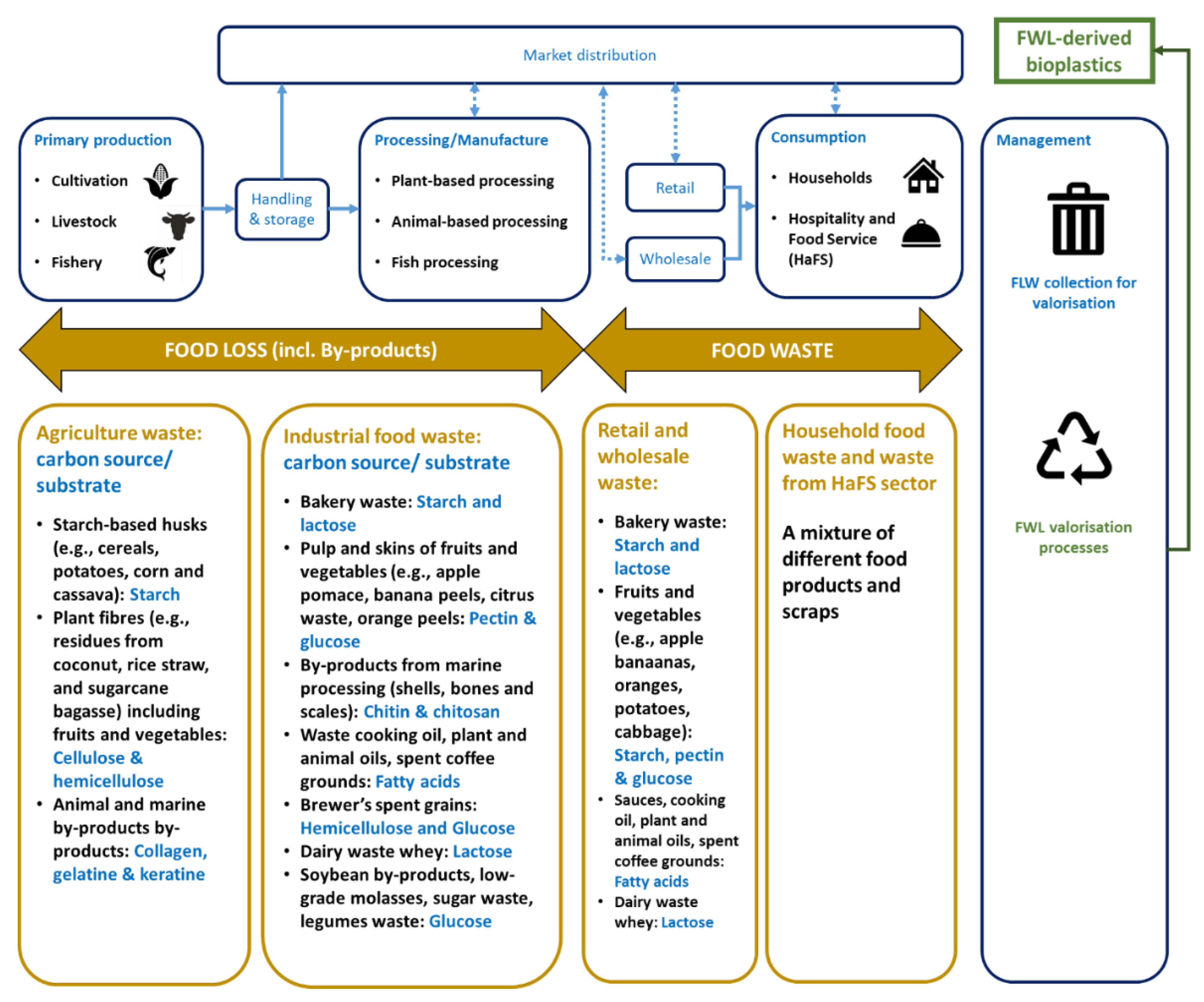
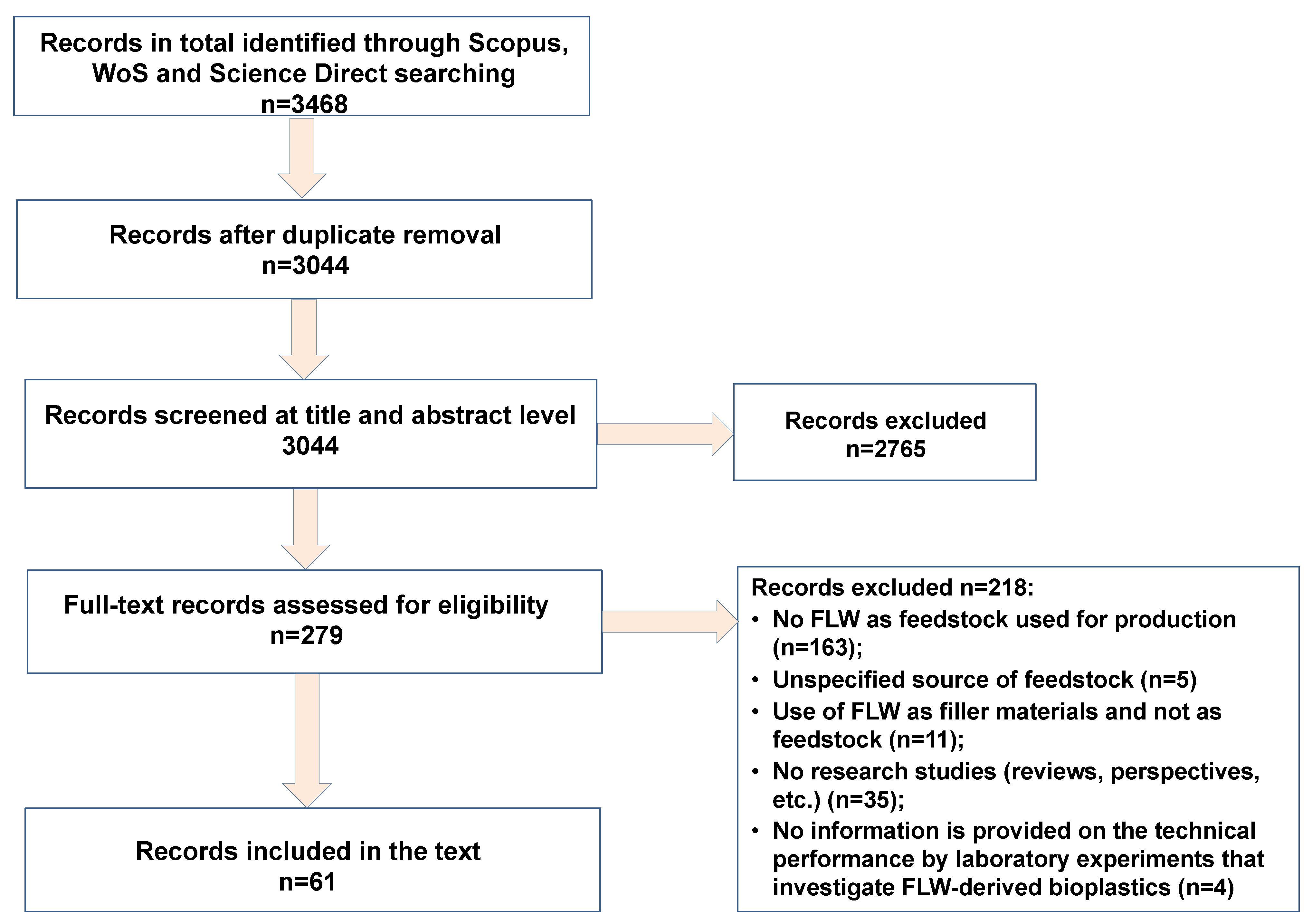
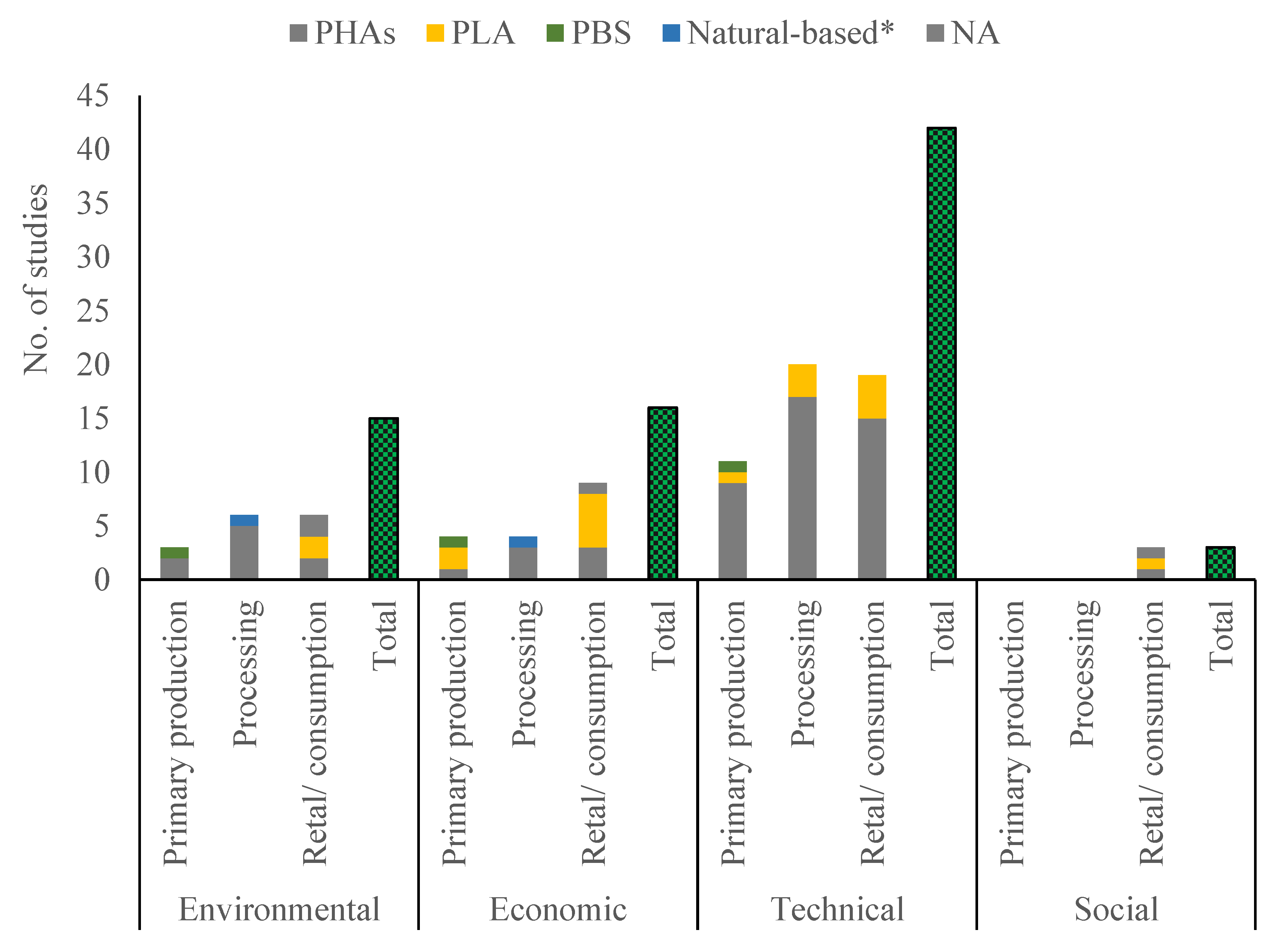

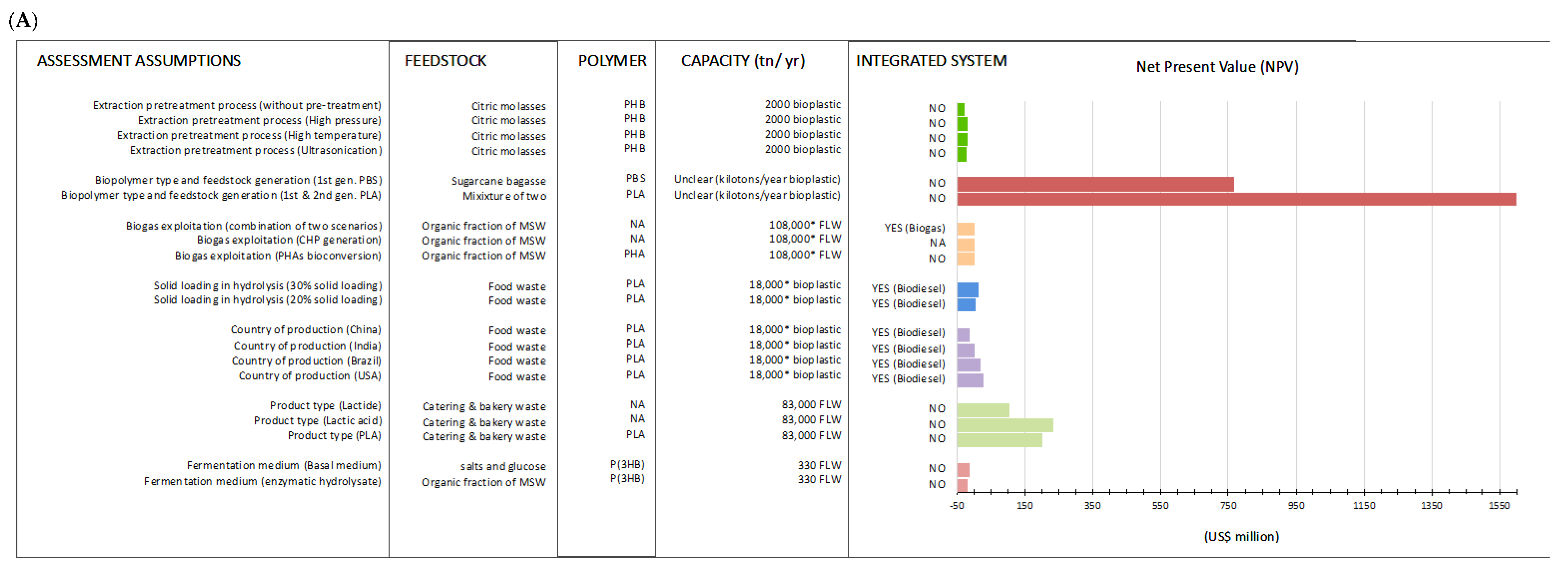

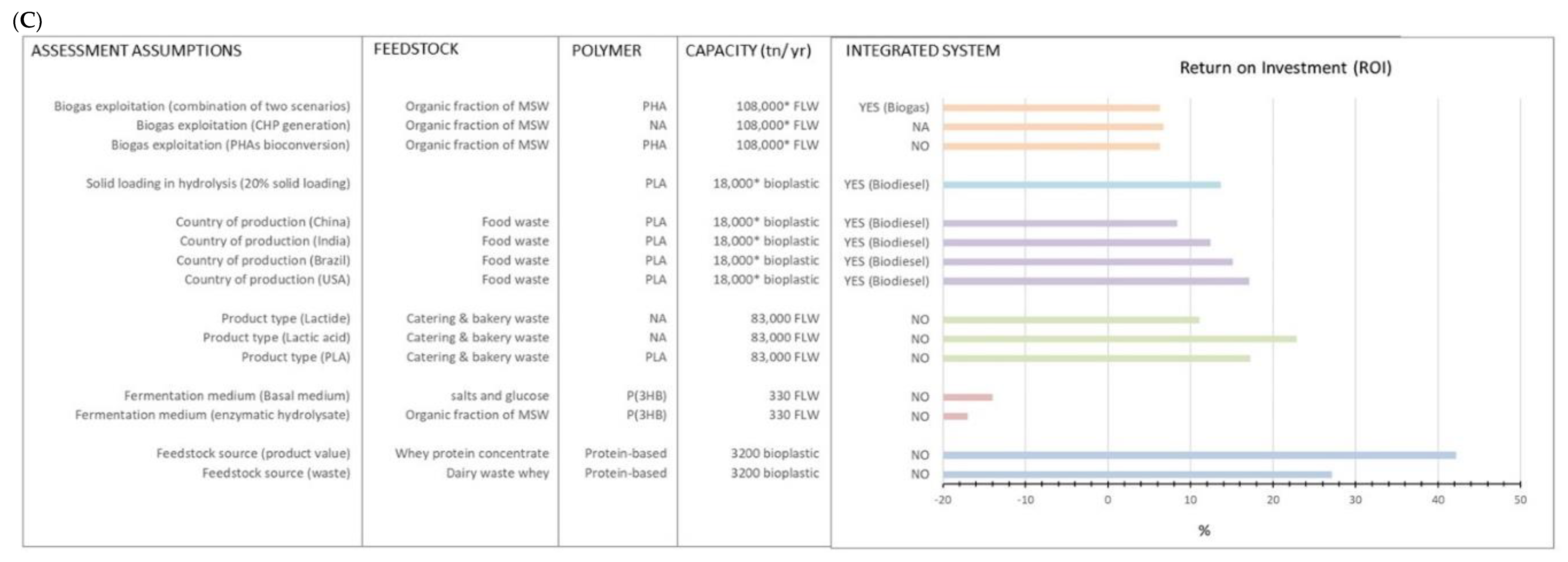

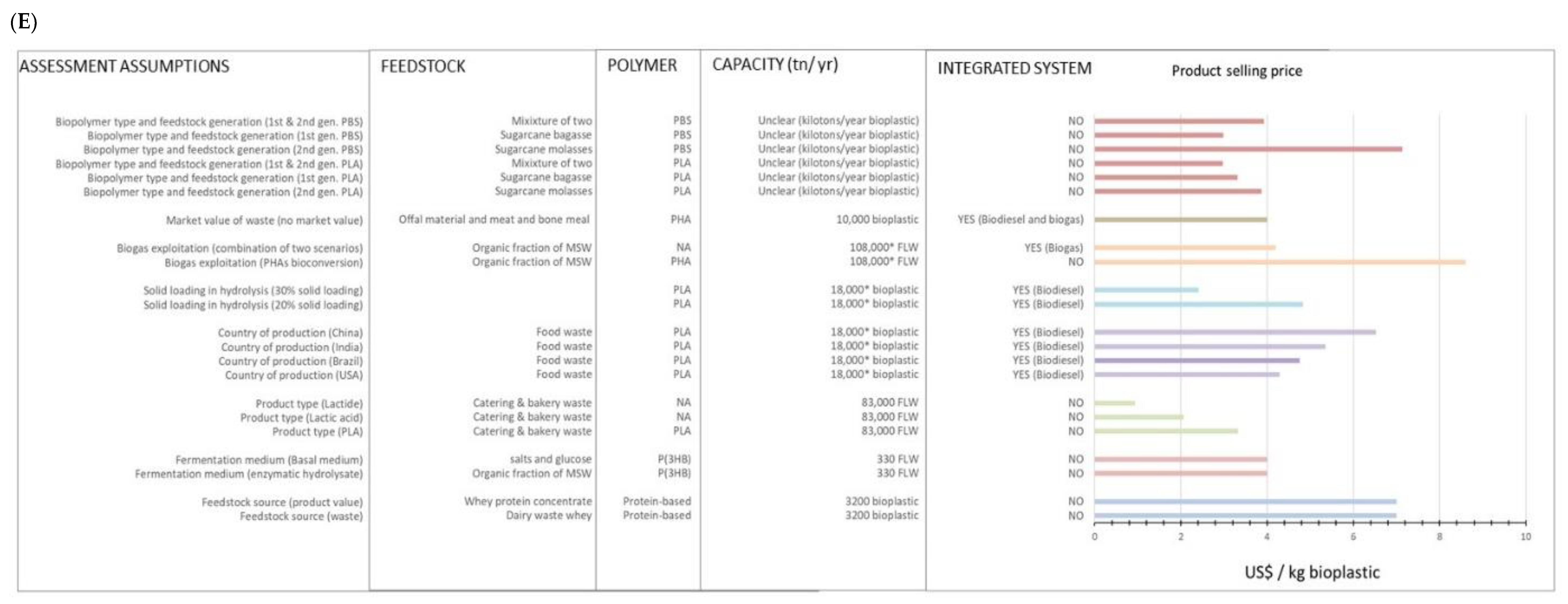
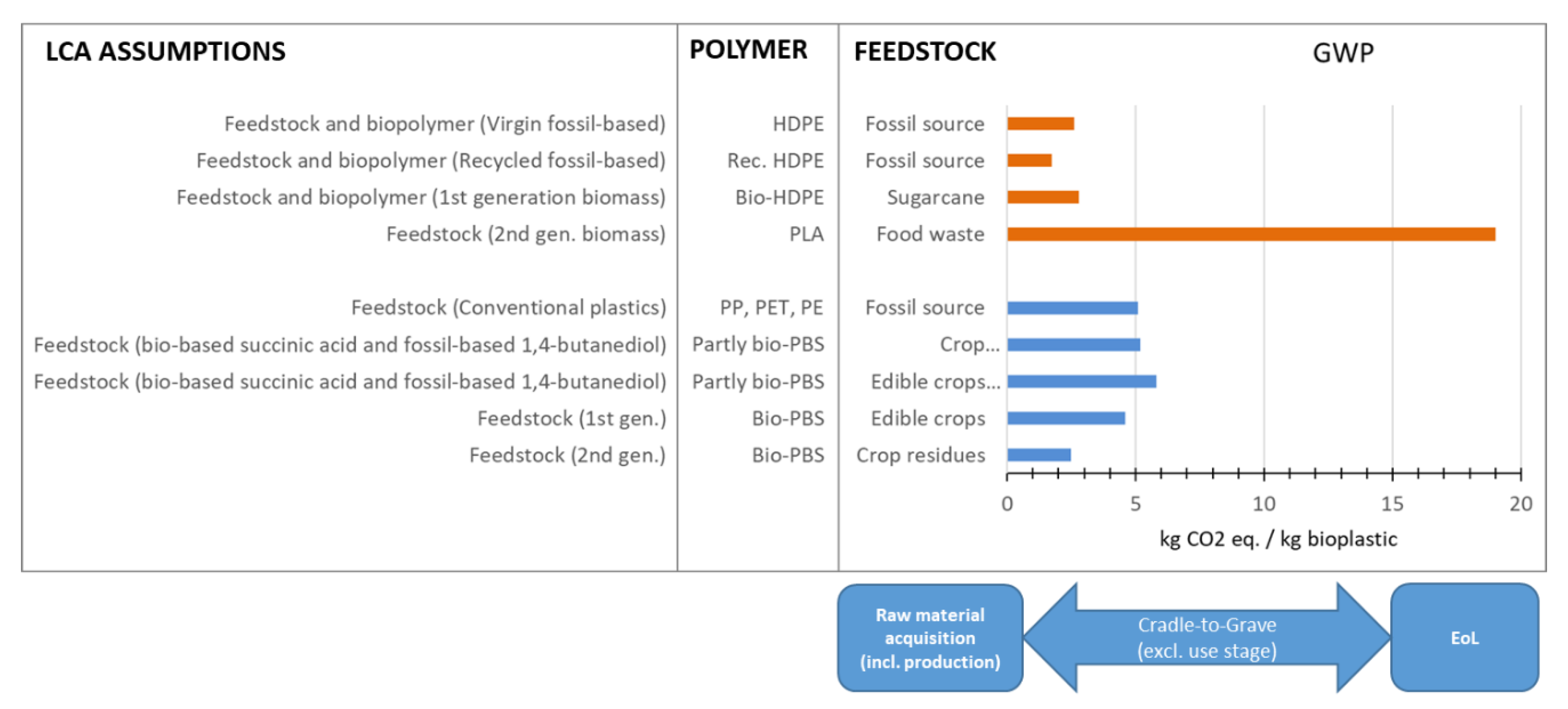
| PO Statement | Inclusion Criteria | Exclusion Criteria | |
|---|---|---|---|
| Population | Bio-based plastics from waste generated across the food value chain | FLW from all stages of the supply chain (e.g., agriculture, processing, household, wholesale and retail, catering) used for bioplastic production; Any type of bio-based plastic produced by FLW. | Bioplastics obtained from primary feedstock (i.e., non-edible crops); Bioplastics from any other non-food secondary and third-generation feedstock (e.g., algae); Unspecified source of feedstock origin; Bio-based plastics that used FLW as filler; Bioplastics produced from mixtures of waste streams (e.g., manure and FLW). |
| Outcome | Sustainability assessments (environmental, economic, technical, social) of FLW-derived bioplastics | Sustainability assessments at any FLW-derived bioplastics’ lifecycle stage; Economic assessments at any FLW-derived bioplastics’ lifecycle stage; No limitation to geographical origin; Studies conducted at any scale (lab, pilot, and industry) that provide insights into technical parameters and their effect on the properties and technological performance of FLW-derived bioplastics. | Perspectives, short communication and opinion letters; Studies focused on exploring the bio-chemical kinetics and processes of converting FLW into a substrate for bioplastics without providing evidence on the properties of bioplastics and production efficiency. |
| Considerations | Aspect | Description | Lifecycle Stage | Amelioration | Reference |
|---|---|---|---|---|---|
| Carbon emissions | Env | Energy-intensive stages that seek to convert FLW into raw materials for bioplastics production. | RMA | 1. Adoption of less energy-intensive processes (e.g., natural withering vs. thermal treatments, dissolved air floatation during extraction); 2. Use renewable resource-based energy systems. | [49,50,51] |
| Formation of degradation products | Env | Lignocellulosic biorefinery (e.g., furfural, hydroxymethylfurfural, phenolics, melanoidins, sugar degradation products) forms toxic by-products that inhibit fermentation. | PROD | Detoxicification process is needed to remove inhibitory compounds. | [52] |
| FLW transportation | Env | Long distances could lead to the degradation of FLW and the development of pathogens as well as considerable consumption of fossil fuels. | RMA | 1. Transport in freezers—but environmentally is energy consuming; 2. Installation of valorisation processes near FLW production hubs (decentralised processes) 3. Reduce transportation distances; | [23,45,46,49] |
| Raw material use (e.g., chemicals and water) | Env | Halogenated and other organic solvents used to aid biopolymer recovery from cell material (e.g., through solvent extraction, selective dissolution and surfactant digestion) may pose occupational hazards; Requirements for water are relatively high. | PROD | 1. Use of non-toxic raw materials during production (e.g., green solvents: CO2 and dimethyl carbonate instead of NaOH and NaCl); 2. Increase solid organic rate—reduce the need for water dilution. | [13,25,43,49] |
| Econ | Primary components required for the bioconversion (i.e., solvents, oxygen supply, chemicals to control the operating conditions, yeast extracts, strains for microbial culture (native vs. recombinant strains) and cultivation media). | PROD | 1. Reduce the number of solvents during the extraction and purification; 2. Use of innate enzymes or mixed cultures. | [24,53,54] | |
| Waste generation | Env, Econ | Considerable amounts of FLW residues could be generated due to the use of specific carbon sources for production, and by-products during extraction and purification could be generated. | PROD | 1. Utilisation of FLW residues (by-products) needs to be explored; 2. Intergrade processes of biopolymer production with bioenergy; 3. Recovery of by-products produced; 4. Increase feedstock to product yield by optimising performance parameters (e.g., optimise growth and accumulation yields of PHA through proper pre-treatment (e.g., chemical vs. biological) and hydrolysis methods (e.g., acid vs. enzyme). | [13,45,51,55,56] |
| Cost-effectiveness | Econ | FLW availability and acquisition (storage and transportation) can affect operational process efficiency and economic effectiveness. | RMA | Installation of valorisation processes near FLW production and management hubs (e.g., large food processing plants, landfills, MSW sorting facilities). | [26] |
| Econ | High moisture content impacts the energy intensity of pre-treatment processes. | RMA | 1. Adoption of less energy-intensive processes; 2. Intergrade processes of biopolymer production with bioenergy. | [57] | |
| Net present value (NPV) | Econ | Feedstock-to-product yield might be low depending on the source and composition of FLW (affected by geographical origin), type of biopolymer, production method, feeding regime, reactor conditions, and microbial strain (incl. assimilability by the microbes). | RMA, PROD | 1. Separate collection of FLW; 2. Intergrade processes of biopolymer production with bioenergy; 3. Use of high-performance strains; 4. Upgrading the fermentation processes; 5. Harnessing the residual biomass (e.g., undigested waste from the enzymatic hydrolysis); 6. Content analysis of FLW substrates to identify components that improve bioconversion; 7. Optimising agitation speed to increase the oxygen transfer rate throughout the fermentation medium; 8. Select optimum pre-treatment, hydrolysis and extraction method in terms of production yields. | [25,43,55,56,58,59] |
| Econ | Waste processing capacity (e.g., the number of batches, amount of feedstock and operation time) defines the economy of scale: the higher the processing capacity, the lower the production cost. | RMA, PROD | 1. Ensuring predefined composition and constant quality of FLW; 2. Fine-tuning the supply of substrates through multi-stage continuous processes and proper feeding regimes; 3. Define clear business plans for commercialisation (considering market demand and feedstock availability). | [24,49,60,61,62] | |
| Capital investment cost | Econ | Equipment, installations, instrumentations and buildings/facilities. | PROD | 1. Implement high solid loadings; 2. Government funding; 3. Reduce process capacity equipment by selecting pre-treatment methods with minimum FLW loss during pre-treatment. | [24,55,63] |
| Utility costs | Econ | Energy-intensive processes (e.g., aeration, agitation, evaporation) and use of other resources (e.g., water) during pre-treatment, hydrolysis and fermentation. | RMA, PROD | 1. Adoption of less energy-intensive processes; 2. Intergrade processes of biopolymer production with bioenergy; 3. Use of innate enzymes or mixed cultures. | [24,53,54] |
| FLW type (heterogeneity and composition) | Econ | The complexity of FLW composition has an impact on the energy pre-treatment and processing requirements and feedstock-to-product yield. | RMA, PROD | 1. Separate collection of FLW; 2. Matching FLW type to different valorisation technology set-ups; 3. Using mixed microbial cultures. | [24,25,54,64] |
| Tech | The carbon to nutrient (i.e., C/N) ratio of FLW might be lower than optimal, leading to metabolic blockage of substrate conversion. | RMA | Fine-tuning the C/N ratio for each bioconversion process depending on the feedstock, biopolymer type, and microbial strains. | [20,25,58] | |
| Tech | Constant feedstock quantity and quality (incl. composition) is a prerequisite for a successful valorisation process. | RMA | 1. Separate collection of FLW; 2. Upgrade logistics of FLW management at the local level; 3. Fine-tuning the supply of substrates through multi-stage continuous processes and proper feeding regimes. | [26,49,62,65] | |
| End-product | Tech | Feedstock: selecting appropriate substrates (or a combination of them) leads to the same polymers that display different properties. | RMA | 1. Blending biopolymers to form biocomposites (still explored); 2. Use of natural additives, and compatibilisers; 3. Developing the product design and logistics; 4. Content analysis of FLW substrates to identify components that improve bioconversion; 5. Use of nanoparticles; 6. Chemical modification of polysaccharides. | [53,58,66,67,68] |
| Tech | Production strategy: methods, operating conditions (i.e., pH, temperature, environment, culture age, nutrient restrictions, bioreactor configurations, hydraulic retention time, recirculation ratio), organic loading rate and feeding strategy determine the properties of bioplastics. | PROD | 1. Fine-tuning the valorisation process to produce bioplastics needed in the market (e.g., through multi-stage continuous processes); 2. Developing the product design and logistics; 3. Improving extraction techniques and bioaugmentation of microbial strains. | [49,69] |
Disclaimer/Publisher’s Note: The statements, opinions and data contained in all publications are solely those of the individual author(s) and contributor(s) and not of MDPI and/or the editor(s). MDPI and/or the editor(s) disclaim responsibility for any injury to people or property resulting from any ideas, methods, instructions or products referred to in the content. |
© 2022 by the authors. Licensee MDPI, Basel, Switzerland. This article is an open access article distributed under the terms and conditions of the Creative Commons Attribution (CC BY) license (https://creativecommons.org/licenses/by/4.0/).
Share and Cite
Gerassimidou, S.; Martin, O.V.; Diaz, G.Y.F.; Wan, C.; Komilis, D.; Iacovidou, E. Systematic Evidence Mapping to Assess the Sustainability of Bioplastics Derived from Food Waste: Do We Know Enough? Sustainability 2023, 15, 611. https://doi.org/10.3390/su15010611
Gerassimidou S, Martin OV, Diaz GYF, Wan C, Komilis D, Iacovidou E. Systematic Evidence Mapping to Assess the Sustainability of Bioplastics Derived from Food Waste: Do We Know Enough? Sustainability. 2023; 15(1):611. https://doi.org/10.3390/su15010611
Chicago/Turabian StyleGerassimidou, Spyridoula, Olwenn V. Martin, Gilenny Yamily Feliz Diaz, Chaoying Wan, Dimitrios Komilis, and Eleni Iacovidou. 2023. "Systematic Evidence Mapping to Assess the Sustainability of Bioplastics Derived from Food Waste: Do We Know Enough?" Sustainability 15, no. 1: 611. https://doi.org/10.3390/su15010611
APA StyleGerassimidou, S., Martin, O. V., Diaz, G. Y. F., Wan, C., Komilis, D., & Iacovidou, E. (2023). Systematic Evidence Mapping to Assess the Sustainability of Bioplastics Derived from Food Waste: Do We Know Enough? Sustainability, 15(1), 611. https://doi.org/10.3390/su15010611










